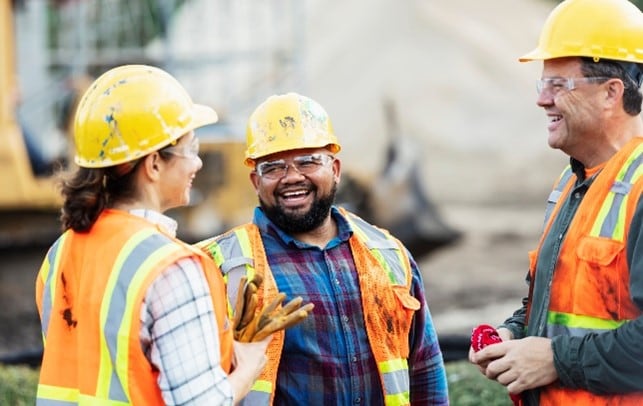Safety Helmets

The National Institute for Occupational Safety and Health (NIOSH) and partners are working to prevent work-related traumatic brain injuries through studying the performance and design of newer safety helmets like those worn in mountain climbing.
Traumatic brain injuries, or TBIs, affect how the brain works. More severe TBIs can impact a worker’s ability to return to their job and be expensive for both workers and employers in long-term rehabilitation and disability costs. The construction industry has the largest number of TBIs among U.S. workplaces.
Construction Worker Injuries
Construction workers are at higher risk for TBIs because of their work environment, which can include falling and flying objects and falls from high objects such as roofs, ladders, and scaffolds.
Research shows that:1
- Workers in small construction companies (<20 employees) were over 2.5 times more likely than those in larger companies (≥100 employees) to die from a TBI.
- Older workers (≥65 years) were almost 4 times more likely than younger workers (25–34 years) to have a fatal TBI.
- The TBI fatality rate was significantly higher for foreign-born than for native-born workers.
- Structural iron and steel workers and roofers had the highest fatal TBI rate among construction workers.
Helmets Can Help
Use of personal protective equipment (PPE) such as helmets remains an essential intervention in many construction settings to prevent injury. Helmets used in the construction industry have ‘Type I’ and ‘Type II’ designations.
- Type I helmets are designed to reduce the risk of injury resulting from a blow to the top of the head.
- Type II helmets are designed to reduce the risk of injury resulting from a blow to either the top or sides of the head.
However, it is becoming increasingly more common for construction workers to use helmets like those typically worn in mountain climbing or ice hockey because they have been found to be more protective2,3. NIOSH’s goal is to improve worker protection by improving the testing methods and shock absorption performance of current helmet design.
Research
Studying the performance and design of safety helmets is one way that NIOSH researchers are working to decrease work-related TBIs. Current research includes:
- Impact tests to simulate struck-by incidents and falls which more closely match actual conditions.
- Effects of chin straps and suspension tightening “ratchets” which avoid detachment of the helmets during both struck-by and fall incidents.
- Improving existing helmet testing methods to better predict helmet performance.
- Improving shock absorption performance by designing improved suspension systems.
NIOSH researchers are also working to improve consensus standards that address helmet performance.
The Bottom Line
Construction workers are at higher risk for traumatic brain injuries due to their work environments. NIOSH researchers are studying the effectiveness of safety helmets to improve protection.
Resources
NIOSH blog post: Construction Helmets and Work-related Traumatic Brain Injury
NIOSH webpage: Working in Construction
CDC webpage: Traumatic Brain Injury / Concussion
CPWR webpage: Preventing Head Injuries
1Konda S, Reichard A, Tiesman HM, Hendricks S [2015]. Nonfatal occupational traumatic brain injuries treated in U.S. hospital emergency departments: 1998-2007. Inj Prev, 21:115-120.
https://injuryprevention.bmj.com/content/injuryprev/21/2/115.full.pdf
2Wu JZ, Pan CS, Cobb C, Moorehead A, Kau TY, and Wimer BM [2022]. Evaluation of the Fall Protection of Type I Industrial Helmets. Annals of Biomedical Engineering. https://www.ncbi.nlm.nih.gov/pmc/articles/PMC9885975/pdf/nihms-1858485.pdf
3Liberty Mutual Safety Brochure: Industrial helmet injury protection from falls. https://image.email-libertymutual.com/lib/ff051670706506/m/3/9d6dba99-a89c-40f6-be14-e7474dc7c652.pdf.
